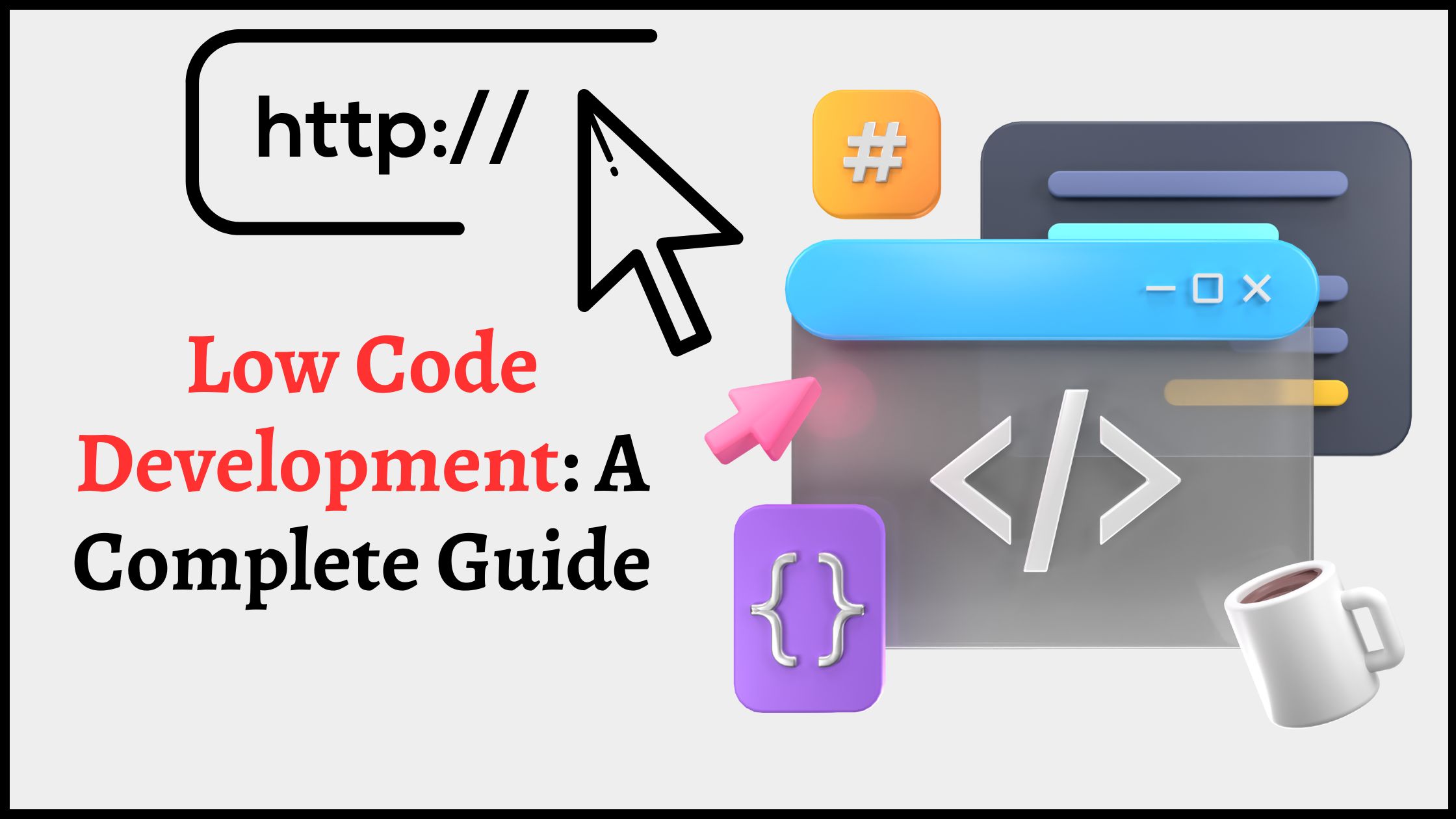- Low Code Development: An Overview
- Benefits of Low Code Development
- Critical Components of Low Code Development
- Difference Between Low-Code, No-Code, and High-Code Development
- What can you Build With Low Code Development?
- What is the Process of Choosing the Right Low Code Development Platform?
- Efficiently Develop and Launch Enterprise-Based Web Solutions With CSSChopper
Today, time is of the essence and efficiency is of utmost importance. Every minute saved, every process streamlined, and every task completed effectively can contribute to growth. To maintain momentum and achieve long-term sustainability, businesses constantly look for innovative ways to accelerate growth. One such method gaining significant traction is low-code development.
Its roots can be traced back to the 2000s and early 1990s. However, the term ‘low-code’ was first introduced in 2014. The pandemic and subsequent digital revolution of 2020 have made low-code development an extremely popular approach. Since then, there has been no looking back. In 2023, its market size reached approximately $10 billion and is expected to reach more than $12 billion by 2024.
This simplifies the development process and helps extend coding from textual to visual. This approach lets businesses invest in software development that fits their strategic goals efficiently and quickly.
Low Code Development: An Overview
Low coding is a software development approach that requires little to no code to build a web solution. Simply put, it’s a modern-day alternative to traditional software development. Instead of utilizing complex programming languages, you can employ visual interfaces with basic logic and drag-and-drop capabilities.
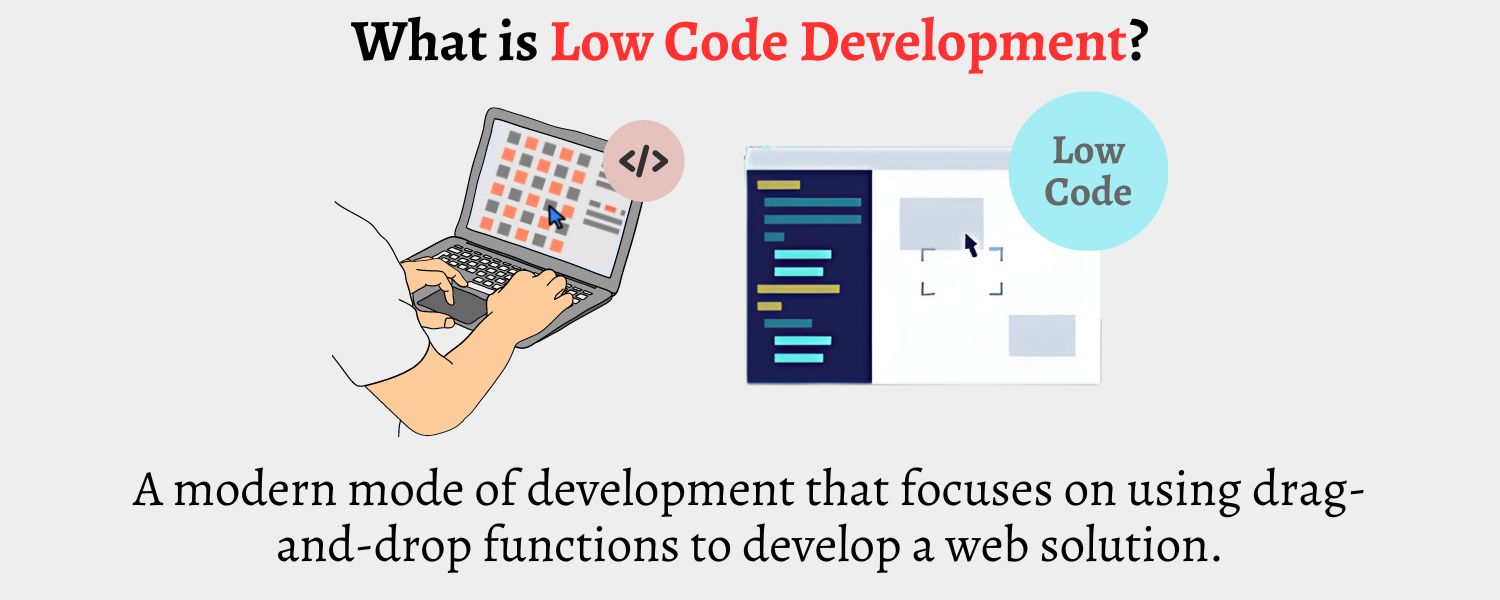
Low-code development platforms have gained popularity over conventional software development because they can be easily and quickly built. These platforms are vital in simplifying coding and making development more accessible. Moreover, this approach has empowered web developers with a flexible and visual environment to develop simple to complex web solutions.
Benefits of Low Code Development
Over the years, low-code development has become one of the most favored approaches to developing web solutions. It involves using visual tools, drag-and-drop interfaces, and pre-built components to make the process quick and effortless. Moreover, low code platforms restrict the customization to some extent, but you can moderately perform it. Here are some of the benefits of this development approach.
1. Reduce Development Time
Developing a web solution using a traditional approach requires extensive coding, which requires extra effort and time. Conversely, low-code development platforms offer a simplified and user-friendly interface that eliminates the need for extensive coding.
2. Increased Productivity
One of the benefits of utilizing this approach in web development is that your hired web developers can work more efficiently. This can only be possible by reusing components and functionalities that lead to faster project completion times.
3. Minimize Poor Coding Practices
The drag-and-drop interface of the low-code development platforms enables developers to create functional web solutions without utilizing extensive coding practices. This results in minimizing the poor coding practices as compared to traditional.
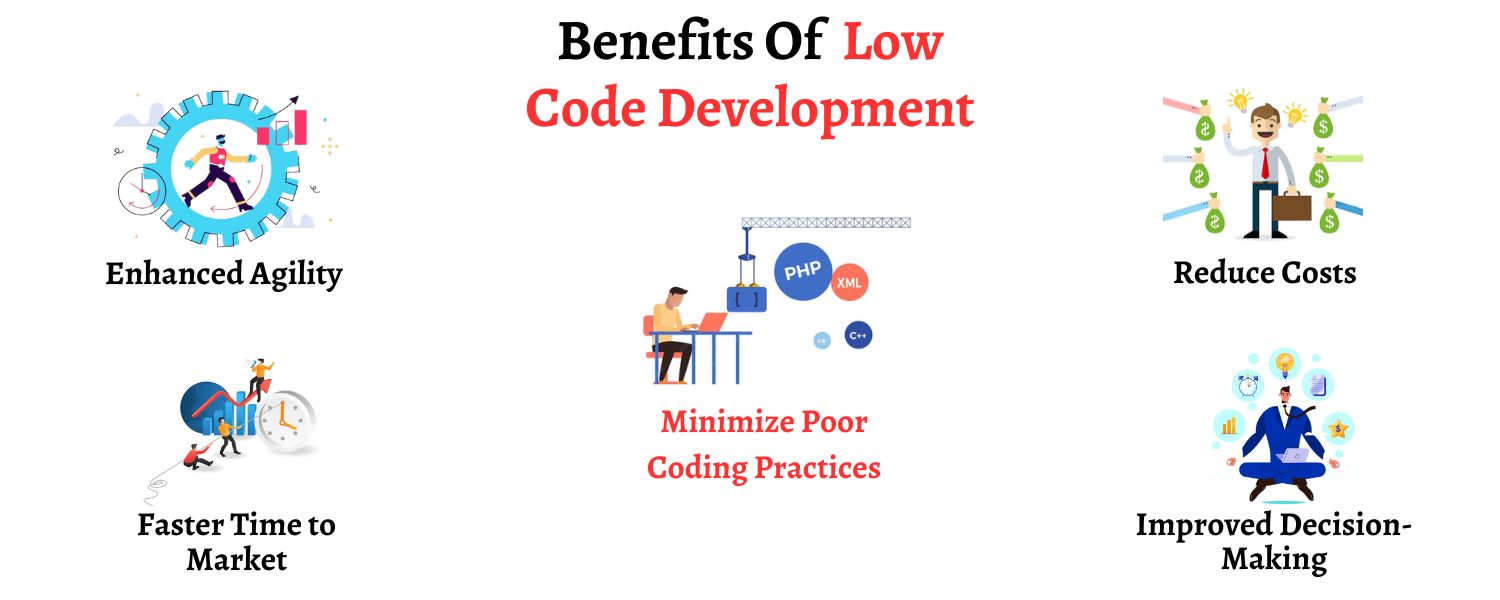
4. Reduce Costs
Low code reduces the need for specialized programming resources, which can help lower development costs. It can also help automate repetitive tasks and further reduce costs. Furthermore, these platforms require fewer developers and reduce the need for specialized coding skills, resulting in lower development costs than traditional methods.
5. Improved Decision-Making
Low-code development enables web developers to make decisions quickly and accurately. But how? This mode of development enables them to prototype the software quickly, allowing them to see results faster. Hence, they can make decisions based on the actual functionality of the developed software.
Simply put, when developers get real-time, actionable insights and allow them to make the required changes based on a business’s needs, they can make decisions more promptly and speed up the development process.
Critical Components of Low Code Development
The low code development platform has various features, making it a versatile and powerful tool for developing web solutions. Some of the main features are elaborated below.
1. Visual Programming Tools
In low-code development, you can see what you are creating. The drag-and-drop feature enables developers to create an intuitive visual user interface. Model-driven development (the foundation of low-code development) helps visualize how the internet-based solution will look and work.
2. Pre-built Components
This newly transformed approach to development is equipped with a library of pre-built components. These include a user interface, data connectors, and business logic modules for implementing specific workflows or processes. Moreover, these components have been tested and are ready to be utilized by reducing the risk of errors. As a result, this helps speed up the development process.
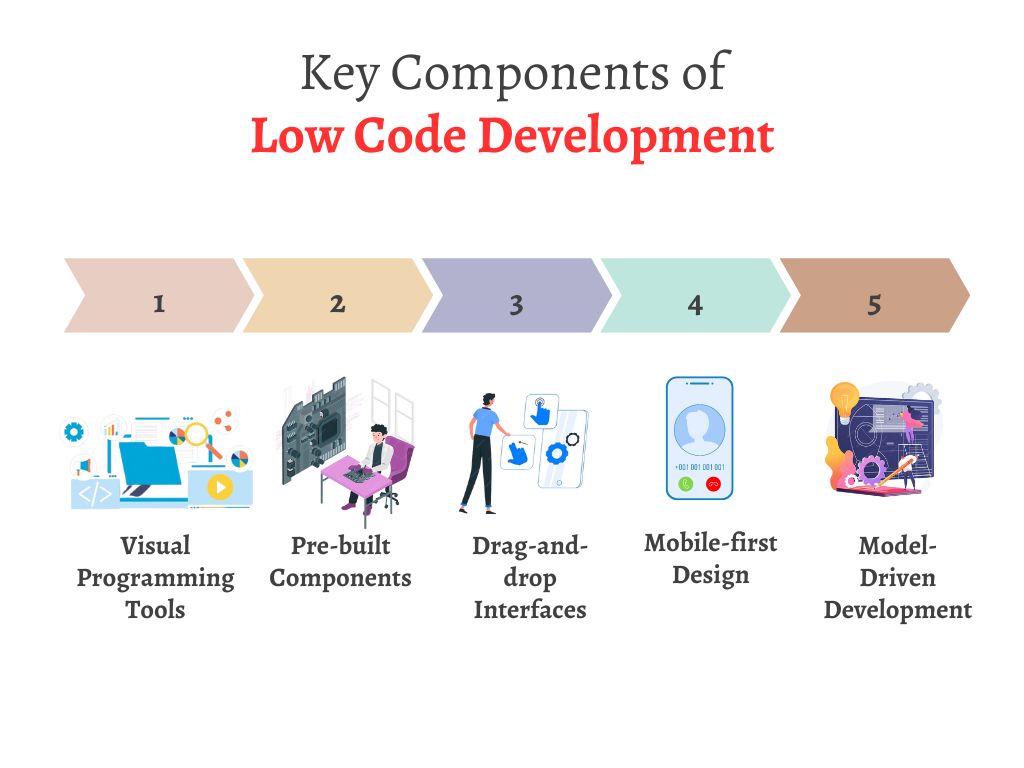
3. Mobile-first Design
Google ranks websites or web apps that work well on any screen size without losing quality. This responsiveness is pivotal in delivering users a seamless and interactive web experience. Low-code, no-code development prioritizes mobile optimization. This confirms that your software, whether a website or a web application, remains responsive and accessible across smaller screen sizes, especially mobile phones.
4. Collaboration Tools
This transformative development approach provides built-in collaboration tools that promote better communication within the team. These tools are helpful for loops in feedback, revision tracking, user stores, and so on. This streamlines the development process by reducing the cost.
Difference Between Low-Code, No-Code, and High-Code Development
Are you in a quandary about choosing between low-code, no-code, and high-code development types? We have made this easier for you. You do not have to vie to attain the right development type. You can look at the differences between them to gain a better understanding.
| Parameters | Low code development | No Code Development | High Code Development |
| Flexibility | Moderate flexibility with built-in components | Predefined templates restrict flexibility | A higher degree of flexibility |
| Development Time | Web application development is quick. | In no-code development platforms, pre-built components make the development fastest | Development time is slower due to manual coding |
| Scalability | Scalable to some extent | Due to predefined frameworks, scalability is limited | Highly scalable mode of development |
| Control | Moderate control | Limited Control | High-level of control |
| Maintenance | Easier maintenance with updates | Minimal maintenance | Requires regular maintenance |
| Customization | Moderate customization | Limited customization | Tailored as per business needs |
| Project Type | Suitable for various project types | Ideal for easier and simpler projects | Highly suited for enterprise-grade projects |
| Cost | Medium to high-cost, depending on the project | Lower cost because of minimal development resources | One has to pay a high sum due to longer development cycles |
| Need for Code | Minimal coding required | No code application development requires zero coding | Extensive coding requires |
| Adaptability | Some sort of adaptability | Less adaptable | Highly adaptable |
| Performance | Moderate | Lower than low-code solutions | Performance-oriented mode of development |
Now, the choice between a low-code, no-code, or high-code mode of development depends on your business’s requirements and the type of project you want to build. Hence, be wise when making the decision.
What can you Build With Low Code Development?
You can utilize low code development platforms to develop a wide range of web solutions, from web applications to CMS platforms. This is not bound to any domain or industry. Let’s delve deeper to understand the solutions we can build using low-code development:
1. Web Application
If you want to build a web application for your business by leveraging the power of low-code development, then you are on the right path. Low-code development enables you to develop web apps that assimilate to your business’s requirements to some extent. However, you can opt for web app development services to embrace the potential of this mode of development.
2. Enterprise-grade Websites
Low-code platforms are suitable for building enterprise-grade websites. Pre-built components and visual interfaces allow for faster website creation than high-code development.
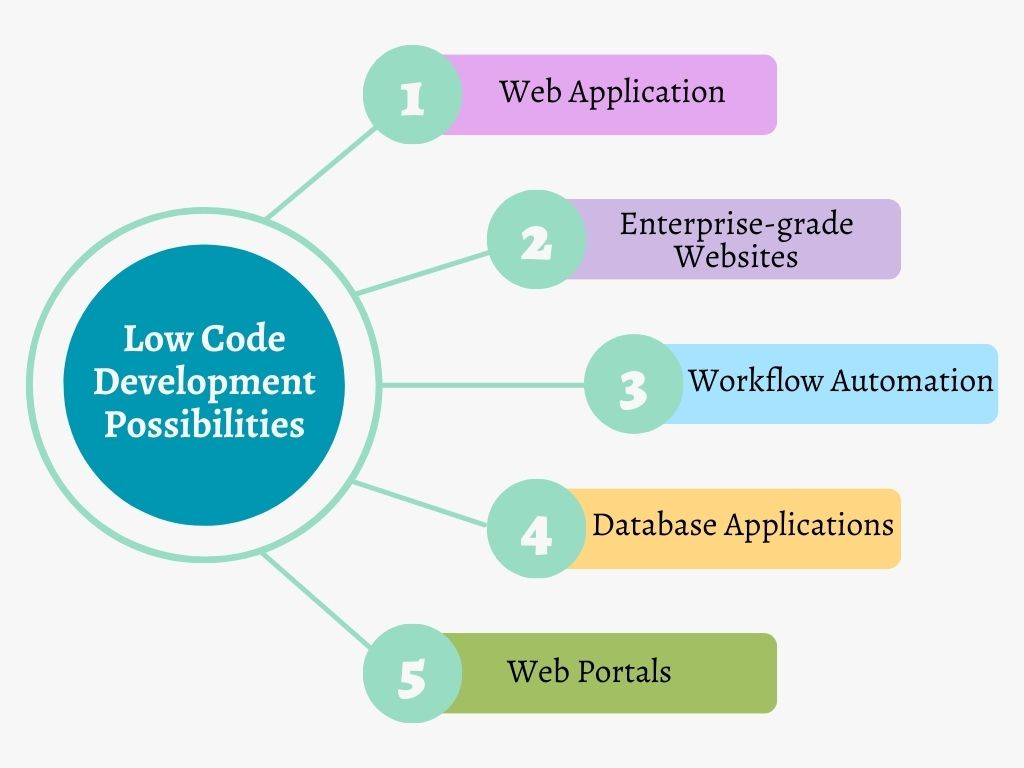
3. Web Portals
With this new and innovative development mode, you can simplify the development of web portals. Not only will this expedite the development process, but portals built using low-code development will be cost-effective and help organizations add new revenue streams.
4. Workflow Automation
Low code development is helpful in building workflow automation solutions. These solutions can streamline the work process through automation.
5. Database Applications
Low-code application development platforms allow the quick development of solutions such as project management systems, CRM tools, and inventory management.
What is the Process of Choosing the Right Low Code Development Platform?
The choice of picking an ideal low-code development platform becomes difficult with the horde of vendors in the market. Every platform is different from the other. Remember, your chosen platform should be able to grapple with your business with the ever-increasing demand.
Hence, the evaluation of the criteria becomes crucial
1. Define Your Needs
Before diving into the journey of choosing the right LCDP for your project; it is crucial to understand the specific requirements of your business. It is vital to have a clear idea of things like,
- The type of project you want to build (whether a mobile app or web application development)
- Complexity of the project
- Skills and expertise of the software development service provider
When you get to know about your specific needs, the path of selecting the right platform for your project becomes easier.
2. Evaluate Data Integration Capabilities
It is crucial to monitor the data integration capabilities of low code development platforms. The ideal way to ascertain this is by considering questions like
- How secure is integrating data?
- Is there any out-of-the-box connectivity to external data?
Questions like this will make finding the right platform for your business easy.
3. Assess Scalability
Keep a check on how scalable this low code development platform is. It should be able to handle large volumes of data by ensuring consistency in performance. You can ascertain questions like
- Does the platform support horizontal scaling by adding more nodes or instances to handle increased traffic load?
- How does the platform adjust resource allocation based on real-time demand?
- How is the data stored and managed?
You can make an informed decision by thoroughly evaluating all the required questions.
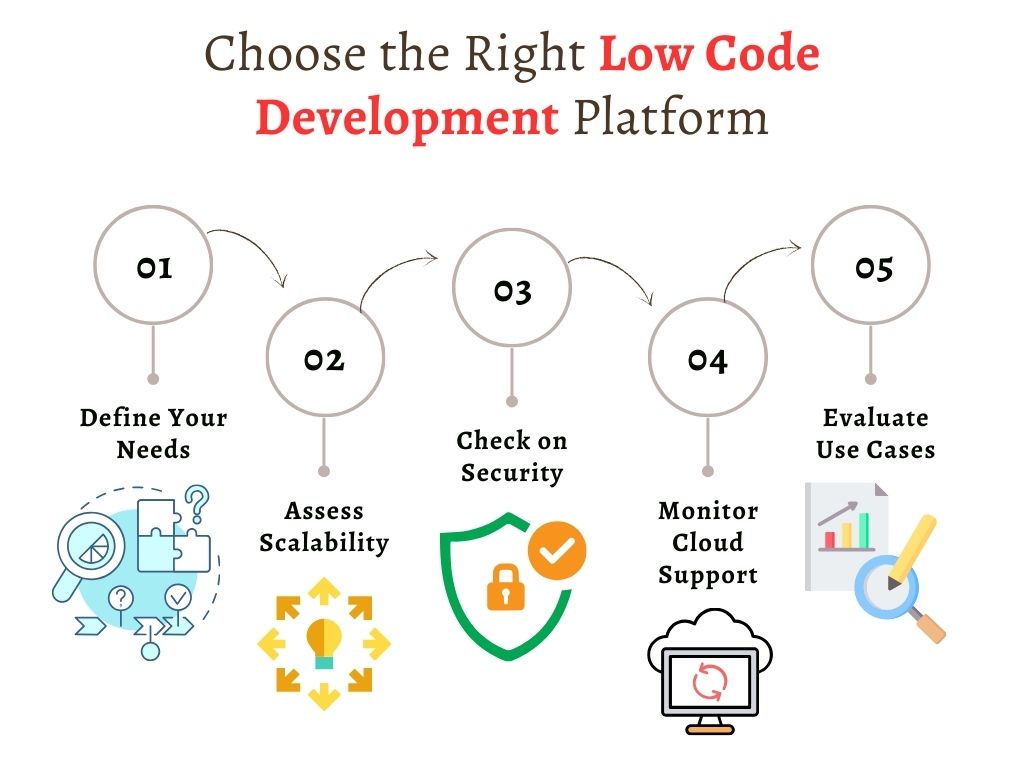
4. Check on Security
Data security is mandatory in web application development. You need to ensure that your chosen platform supports the power-packed security measures. These are encryption, access control, two-factor authentication, and so on. Not only that, it should also comply with the relevant regulations like (HIPAA or GDPR).
5. Monitor Cloud Support
Remember that the low code development platform you are picking should support the cloud. You can ascertain this by considering questions like
- Does the platform guarantee maximum uptime? If yes, then how?
- Is there a process for migrating web applications from one cloud to another? Do you require software development services to make the process easier?
Questions like this will help you make the right choice.
6. Evaluate Use Cases
It is an ideal way to help you find the right low code development platforms that relate to your project needs. You can visualize the possibilities by seeing the products you can build using a particular platform. You can ask yourself questions like
- What type of web solution do you want to build?
- Are you looking for a basic productivity solution?
- Is the platform suitable for enterprise-grade solutions?
- How complex is your project?
Look into your business requirements and find the answer to help you get out of this quandary.
Efficiently Develop and Launch Enterprise-Based Web Solutions With CSSChopper
Low code development methods hold an edge over conventional software development approaches. This development mode is bridging the gap between technical complexity and business agility. This approach has gained traction, but it is bound in some aspects: restricted flexibility, limited control, and security issues.
When you want to develop enterprise-grade web solutions using this mode, its challenges are the most significant setbacks. This is where CSSChopper can help you. As an eminent web app development company, we will evaluate your needs and choose the right platform. Our team will perform a hybrid approach to leverage the speed and ease of the platform while building bespoke software.
Our experienced web developers are skilled in identifying and addressing security glitches and potential threats concerned with low-code development platforms. We have worked with various clients in different industries, including healthcare, real estate, edtech, etc. Our work precision, client-centric approach, and agile development methods are the pillars of our work.
Categories
Recent Posts
Popular Posts
- How to Choose a Reliable Offshore Development Partner?
- Transforming Web Development with HTMX’s Declarative Approach for Dynamic UIs
- How to Outsource Web Development in 2025: Complete Guide
- What are the Top Web Development Trends for 2025?
- 5 Important Aspects to Consider When You Hire a PHP Developer

